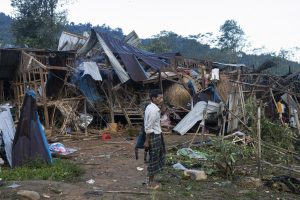Around 30 people, including women and children, were killed in Myanmar in an artillery strike on a camp for displaced people in Kachin State near the border with China, resistance groups say, in one of the military’s deadliest on civilians since seizing power in a coup in February 2021.
The rebel Kachin Independence Army (KIA) said that the attack hit the Mung Lai Hkyet camp for internally displaced civilians to the north of the town of Laiza at around 11:25 p.m. local time. The camp was home to around 500 people, part of a large population of internally displaced people who have been driven out of their homes by military assaults over the past decade.
Col. Naw Bu, a spokesperson for the KIA, told The Associated Press that 29 people, including 11 children under the age of 16, were killed and 57 others injured in the air attacks. The National Unity Government, which is coordinating the resistance to the military government, claims that “based on initial reports, at least 30 have been killed, including women and 13 children and at least a further 57 have been injured.”
Laiza sits on the Chinese border about 324 kilometers northeast of Mandalay, Myanmar’s second-biggest city, and 100 kilometers south of the state capital Myitkyina.
It was unclear exactly how the attack was carried out. Naw Bu told Myanmar Now that the attack was not preceded by the sound of approaching jet fighters. The absence of such a sound, which civilian populations in the area have come to associate with impending air attacks, could indicate that the camp was hit by air-to-ground missiles or by an armed drone.
“We didn’t hear the sound of any aircraft flying past before the attack. We suspect that it could be a drone strike,” he said. “I was told the bomb was dropped right on the camp.”
The use of drones, if confirmed, would represent a new frontier in the Myanmar military’s escalating assaults on the country’s resistance forces. Over the past decade, the military has acquired military-grade attack drones from China, most notably CH-3A drones, which are capable of both reconnaissance and ground attacks. However, aside from a reported attack in Rakhine State in 2020, the military is not known to have used drones in its attacks on armed rebel groups, even as some PDFs have used refitted civilian drones to attack junta forces.
In an emailed statement yesterday, the NUG condemned the attack as “inhumane” and said that it “stands strongly together with the people of Kachin.”
“The terrorist military council has taken advantage of the moment of the international community’s attention on the recent developments of the Israel-Hamas conflict to commit yet another crime against humanity and war crime,” it stated. The attack was also condemned by the British Embassy and the United Nations office in Myanmar.
Junta spokesperson Maj.-Gen. Zaw Min Tun denied that the Myanmar military was responsible for the Laiza attack, and said that the military administration was “still investigating the cause of the explosion,” as state media reported his comments.
The KIA is one of Myanmar’s largest ethnic rebel groups, which along with its political wing, the Kachin Independence Organization (KIO), has been fighting for independence since 1960.
The area around Laiza is not far from the area where KIA troops have faced off against government forces since 2011, when a 17-year ceasefire collapsed. The simmering conflict has since displaced thousands of civilians, who are living in IDP camps to the north and south of Laiza.
Since the 2021 coup, the KIA has emerged as a prominent supporter of the People’s Defense Forces, the NUG-affiliated militias that have been formed to oppose the military administration, providing them with training, sanctuary, weapons, and other forms of support.
Myanmar’s air force has conducted a number of air strikes on resistance forces and civilian populations deemed to be supporting them, including in Kachin State. In October of last year, the Myanmar Air Force launched an air attack on a public concert held by KIO in remote Hpakant township. The concert was part of a three-day celebration marking the 62nd anniversary of the KIO’s founding, and killed as many as 80 people, including Kachin officers and soldiers, singers and musicians, and other civilians.
However, the military had not previously attacked the Laiza area on such a scale, given the risk that the attack might stray into Chinese territory and provoke Beijing’s anger. The fact that it is willing to do so now suggests that it is resorting to ever more desperate measures to crush the stubbornly resistant opposition to its rule, almost ensuring further atrocities of this nature.

































